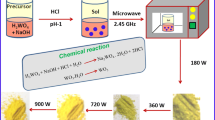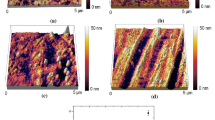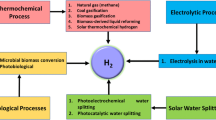Abstract
Gamma radiation can cause structural defects in metal oxide thin films, affecting their conversion efficiency. This study focuses on synthesizing and characterizing Tungsten oxide (WO3) films for photo-electrochemical (PEC) water-splitting applications. The pristine WO3 film was irradiated with a Co-60 gamma source to improve its photocatalytic activity and was named G-WO3. The resulting G-WO3 thin films showed a decrease in the optical direct band gap and showed higher photocurrent density and lower charge transfer resistance for PEC applications. The carrier charge density (Nd) values were found to be increased after γ-radiation. The synthesized G-WO3 thin films possess good stability and reusability for photo-electrochemical water-splitting applications.







Similar content being viewed by others
References
Winter M, Brodd RJ (2004) What are batteries, fuel cells, and super-capacitors? Chem Rev 104:4245. https://doi.org/10.1021/cr020730k
Chen Z, Dinh HN, Miller E (2013) Photoelectrochemical water splitting. Springer, New York. https://doi.org/10.1007/978-1-4614-8298-7
Ting Z (2023) Springer briefs in energy. Photoelectrochemical water splitting standards, experimental methods, and protocols. Accessed 6 July 2023. https://www.academia.edu/44179757/SPRINGER_BRIEFS_IN_ENERGY_Photoelectrochemical_Water_Splitting_Standards_Experimental_Methods_and_Protocols
Wang G, Wang H, Ling Y, Tang Y, Yang X, Fitzmorris RC, Wang C, Zhang JZ, Li Y (2011) Hydrogen-treated TiO2 nanowire arrays for photoelectrochemical water splitting. Nano Lett 11(7):3026–3033. https://doi.org/10.1021/nl201766h
Zhang Z, Zhang L, Hedhili MN, Zhang H, Wang P (2013) Plasmonic gold nanocrystals coupled with photonic crystal seamlessly on TiO2 nanotube photoelectrodes for efficient visible light photoelectrochemical water splitting. Nano Lett 13(1):14–20. https://doi.org/10.1021/nl3029202
Zhonghai Zhang Md, Hossain F, Takahashi T (2010) Photoelectrochemical water splitting on highly smooth and ordered TiO2 nanotube arrays for hydrogen generation. Int J Hydrog Energy 35(16):8528–8535. https://doi.org/10.1016/j.ijhydene.2010.03.032
Sivula K, Le Formal F, Graetzel M (2011) Solar water splitting: progress using hematite (Fe2O3) photoelectrodes. ChemSusChem 4:432–49. https://doi.org/10.1002/cssc.201000416
Cesar I, Kay A, Gonzalez Martinez JA, Grätzel M (2006) Translucent thin film Fe2O3 photoanodes for efficient water splitting by sunlight: nanostructure-directing effect of Si-doping. J Am Chem Soc 128(14):4582–4583. https://doi.org/10.1021/ja060292p
Liu Y, Zhen X, Yin M, Fan H, Cheng W, Linfeng L, Song Y, Ma J, Zhu X (2015) Enhanced photoelectrocatalytic performance of α-Fe2O3 thin films by surface plasmon resonance of Au nanoparticles coupled with surface passivation by atom layer deposition of Al2O3. Nanoscale Res Lett 10(1):374. https://doi.org/10.1186/s11671-015-1077-y
Donge W, Li R, Zhu J, Shi J, Han J, Zong X (2012) Photocatalytic water oxidation on BiVO4 with the electrocatalyst as an oxidation cocatalyst: essential relations between electrocatalyst and photocatalyst. J Phys Chem C 116(8):5082–89. https://doi.org/10.1021/jp210584b
Jo WJ, Jang J-W, Kong K-j, Kang HJ, Kim JY, Jun H, Parmar KPS, Lee JS (2012) Phosphate doping into monoclinic BiVO4 for enhanced photoelectrochemical water oxidation activity. Angew Chem Int Ed 51(13):3147–51. https://doi.org/10.1002/anie.201108276
Wang D, Hongfu Jiang X, Zong QX, Ma Y, Li G, Li C (2011) Crystal facet dependence of water oxidation on BiVO4 sheets under visible light irradiation. Chem A Eur J 17(4):1275–82. https://doi.org/10.1002/chem.201001636
Steinfeld A (2002) Solar hydrogen production via a two-step water-splitting thermochemical cycle based on Zn/ZnO redox reactions. Int J Hydrog Energy 27:611–619. https://doi.org/10.1016/S0360-3199(01)00177-X
Wolcott A, Smith WA, Kuykendall TR, Zhao Y, Zhang JZ (2009) Photoelectrochemical study of nanostructured ZnO thin films for hydrogen generation from water splitting. Adv Func Mater 19(12):1849–1856. https://doi.org/10.1002/adfm.200801363
Maeda K, Domen K (2010) Solid solution of GaN and ZnO as a stable photocatalyst for overall water splitting under visible light. Chem Mater 22(3):612–623. https://doi.org/10.1021/cm901917a
Tacca A, Meda L, Marra G, Savoini A, Caramori S, Cristino V, Bignozzi CA et al (2012) Photoanodes based on nanostructured WO3 for water splitting. Chemphyschem: Eur J Chem Phys Phys Chem 13(12):3025–34. https://doi.org/10.1002/cphc.201200069
Hameed A, Gondal M, Yamani Zain (2004) Effect of transition metal doping on photocatalytic activity of WO3 for water splitting under laser illumination: role of 3d-orbitals. Catal Commun 5:715–19. https://doi.org/10.1016/j.catcom.2004.09.002
Enesca A, Duta A, Schoonman J (2007) Study of photoactivity of tungsten trioxide (WO3) for water splitting. Thin Solid Films 515:6371–6374. https://doi.org/10.1016/j.tsf.2006.11.135
Dias P, Lopes T, Meda L, Andrade L, Mendes A (2016) Photoelectrochemical water splitting using WO3 photoanodes: the substrate and temperature roles. Phys Chem Chem Phys 18(7):5232–5243. https://doi.org/10.1039/C5CP06851G
Kalanur SS, Yoo I-H, Eom K, Seo H (2018) Enhancement of photoelectrochemical water splitting response of WO3 using Bi doping. J Catal 357:127–137. https://doi.org/10.1016/j.jcat.2017.11.012
Zheng H, Jian Zhen O, Strano MS, Kaner RB, Mitchell A, Kalantar-Zadeh K (2011) Nanostructured tungsten oxide – properties, synthesis, and applications. Adv Funct Mater 21(12):2175–96. https://doi.org/10.1002/adfm.201002477
Long H, Zeng W, Zhang He (2015) Synthesis of WO3 and Its gas sensing: a review. J Mater Sci: Mater Electron. https://doi.org/10.1007/s10854-015-2896-4
Zhuiykov S (2014) Nanostructured semiconductor oxides for the next generation of electronics and functional devices. Woodhead Publishing, Oxford
Wang Z, Ming Hu, Wang Y, Xiangcheng L, Qin Y (2016) Effect of solvothermal reaction temperature on the morphology of WO3 nanocrystals and their low-temperature NO2-sensing properties. J Alloy Compd. https://doi.org/10.1016/j.jallcom.2016.01.056
Anithaa AC, Lavanya N, Asokan K, Sekar C (2015) WO3 nanoparticles based direct electrochemical dopamine sensor in the presence of ascorbic acid. Electrochim Acta 167:294–302. https://doi.org/10.1016/j.electacta.2015.03.160
Hariharan V, Radhakrishnan S, Parthibavarman M, Dhilipkumar R, Sekar C (2011) Synthesis of polyethylene glycol (PEG) assisted tungsten oxide (WO3) nanoparticles for L-dopa bio-sensing applications. Talanta 85(4):2166–2174. https://doi.org/10.1016/j.talanta.2011.07.063
Marzouk MA, ElBatal FH, Eisa WH, Ghoneim NA (2014) Comparative spectral and shielding studies of binary borate glasses with the heavy metal oxides SrO, CdO, BaO, PbO or Bi2O3 before and after gamma irradiation. J Non-Cryst Solids 387:155–160. https://doi.org/10.1016/j.jnoncrysol.2014.01.002
Kwong WL, Qiu H, Nakaruk A, Koshy P, Sorrell CC (2013) Photoelectrochemical properties of WO3 thin films prepared by electrodeposition. Energy Proc 34:617–626. https://doi.org/10.1016/j.egypro.2013.06.793
Rodríguez-Pérez M, Chacón C, Palacios-González E, Rodríguez-Gattorno G, Oskam G (2014) Photoelectrochemical water oxidation at electrophoretically deposited WO3 films as a function of crystal structure and morphology. Electrochim Acta, Electrochem New Era 140:320–331. https://doi.org/10.1016/j.electacta.2014.03.022
Zhu T, Chong MN, Phuan YW, Chan E-S (2015) Electrochemically synthesized tungsten trioxide nanostructures for photoelectrochemical water splitting: influence of heat treatment on physicochemical properties, photocurrent densities and electron shuttling. Colloids Surf, A 484:297–303. https://doi.org/10.1016/j.colsurfa.2015.08.016
Fujimoto I, Wang N, Saito R, Miseki Y, Gunji T, Sayama K (2014) WO3/BiVO4 composite photoelectrode prepared by improved auto-combustion method for highly efficient water splitting. Int J Hydrog Energy 39(6):2454–2461. https://doi.org/10.1016/j.ijhydene.2013.08.114
Chatchai P, Kishioka S-y, Murakami Y, Nosaka AY, Nosaka Y (2010) Enhanced photoelectrocatalytic activity of FTO/WO3/BiVO4 electrode modified with gold nanoparticles for water oxidation under visible light irradiation. Electrochim Acta 55(3):592–596. https://doi.org/10.1016/j.electacta.2009.09.032
Alrehaily LM, Joseph JM, Biesinger MC, Guzonas DA, Wren JC (2012) Gamma-radiolysis-assisted cobalt oxide nanoparticle formation. Phys Chem Chem Phys 15(3):1014–1024. https://doi.org/10.1039/C2CP43094K
Abdelghany AM, Hammad AH (2015) The effect of WO3 dopant on the structural and optical properties of ZnO–P2O5 glass and the effect of gamma irradiation. J Mol Struct 1081:342–347. https://doi.org/10.1016/j.molstruc.2014.10.055
Reiff SC, LaVerne JA (2015) Gamma and He ion radiolysis of copper oxides. J Phys Chem C 119(16):8821–8828. https://doi.org/10.1021/acs.jpcc.5b02079
Anithaa AC, Asokan K, Sekar C (2017) Highly sensitive and selective serotonin sensor based on gamma ray irradiated tungsten trioxide nanoparticles. Sens Actuators, B Chem 238:667–675. https://doi.org/10.1016/j.snb.2016.07.098
Arshak K, Korostynska O (2006) Response of metal oxide thin film structures to radiation. Mater Sci Eng, B 133(1):1–7. https://doi.org/10.1016/j.mseb.2006.06.012
Lavanya N, Anithaa AC, Sekar C, Asokan K, Bonavita A, Donato N, Leonardi SG, Neri G (2017) Effect of gamma irradiation on structural, electrical and gas sensing properties of tungsten oxide nanoparticles. J Alloy Compd 693:366–372. https://doi.org/10.1016/j.jallcom.2016.09.137
Kolhe P, Mutadak P, Maiti N, Sonawane K (2020) Synthesis of WO3 nanoflakes by hydrothermal route and its gas sensing application. Sens Actuators, A 304:111877. https://doi.org/10.1016/j.sna.2020.111877
Shinde P, Sharma V, Punde A, Waghmare A, Vairale P, Hase Y, Pandharkar S, Bhorde A, Aher R, Nair S, Doiphode V, Jadkar V, Patil N, Rondiya S, Prasad M, Jadkar S (2021) 2D alignment of zinc oxide@ZIF8 nanocrystals for photoelectrochemical water splitting. New J Chem 45(7):3498–3507. https://doi.org/10.1039/D0NJ05567K
Dongale TD, Mohite SV, Bagade AA, Kamat RK, Rajpure KY (2017) Bio-mimicking the synaptic weights, analog memory, and forgetting effect using spray deposited WO3 memristor device. Microelectron Eng 183–184:12–18. https://doi.org/10.1016/j.mee.2017.10.003
Kolhe PS, Shirke PS, Maiti N, More MA, Sonawane KM (2019) Facile Hydrothermal synthesis of WO3 nanoconifer thin film: multifunctional behavior for gas sensing and field emission applications. J Inorg Organomet Polym Mater 29(1):41–48. https://doi.org/10.1007/s10904-018-0962-0
Ruan Q, Bayazit MK, Kiran V, Xie J, Wang Y, Tang J (2019) Key factors affecting photoelectrochemical performance of g-c3n4 polymer Films. Chem Commun 55(50):7191–7194. https://doi.org/10.1039/C9CC03084K
Mohamedkhair AK, Drmosh QA, Qamar M, Yamani ZH (2021) Tuning structural properties of WO3 thin films for photoelectrocatalytic water oxidation. Catalysts 11(3):381. https://doi.org/10.3390/catal11030381
Deepika DG, Chauhan V, Mahajan A, Rashi Gupta S, Ali A, Kumar R (2023) Influence of gamma radiation on optical, structural and surface morphological properties of WO3 thin films grown by RF sputtering. Radiat Phys Chem 202:110554. https://doi.org/10.1016/j.radphyschem.2022.110554
Mouratis K, Tudose IV, Romanitan C, Pachiu C, Popescu M, Simistiras G, Couris S, Suchea MP, Koudoumas E (2022) WO3 films grown by spray pyrolysis for smart windows applications. Coatings 12(4):545. https://doi.org/10.3390/coatings12040545
Ross-Medgaarden EI, Wachs IE (2007) Structural determination of bulk and surface tungsten oxides with UV–vis diffuse reflectance spectroscopy and raman spectroscopy. J Phys Chem C 111(41):15089–15099. https://doi.org/10.1021/jp074219c
Johansson MB, Niklasson GA, Österlund L (2012) Structural and optical properties of visible active photocatalytic WO3 thin films prepared by reactive DC magnetron sputtering. J Mater Res 27(24):3130–3140. https://doi.org/10.1557/jmr.2012.384
Mu W, Qianghong Y, Rui H, Li X, Wei H, Jian Y (2017) Porous three-dimensional reduced graphene oxide merged with WO3 for efficient removal of radioactive strontium. Appl Surf Sci 423:1203–11. https://doi.org/10.1016/j.apsusc.2017.06.206
Dongale TD, Mohite SV, Bagade AA, Gaikwad PK, Patil PS, Kamat RK, Rajpure KY (2015) Development of Ag/WO3/ITO thin film memristor using spray pyrolysis method. Electron Mater Lett 11(6):944–948. https://doi.org/10.1007/s13391-015-4180-4
Ben Naceur J, Gaidi M, Bousbih F, Mechiakh R, Chtourou R (2012) Annealing effects on microstructural and optical properties of nanostructured-TiO2 thin films prepared by sol-gel technique. Curr Appl Phys 12(2):422–428. https://doi.org/10.1016/j.cap.2011.07.041
Ben Rabeh M, Khedmi N, Fodha MA, Kanzari M (2014) The effect of thickness on optical band gap and N-type conductivity of CuInS2 thin films annealed in air atmosphere. Energy Proc 44:52–60. https://doi.org/10.1016/j.egypro.2013.12.009
Chua CS, Ansovini D, Lee CJJ, Teng YT, Ong LT, Dongzhi Chi TS, Hor A, Raja R, Lim Y-F (2016) The Effect of crystallinity on photocatalytic performance of Co3O4 water-splitting cocatalysts. Phys Chem Chem Phys 18(7):5172–5178. https://doi.org/10.1039/C5CP07589K
Sharma P, Doiphode P, Bhorade O, Yengantiwar A (2020) Bismuth vanadate thin films for efficient photoelectrochemical water splitting. Emerg Mater 3(2):187–194. https://doi.org/10.1007/s42247-020-00093-2
Hammad AS, El-Bery HM, El-Shazly AH, Elkady MF (2018) Effect of WO3 morphological structure on its photoelectrochemical properties. Int J Electrochem Sci 13(1):362–72. https://doi.org/10.20964/2018.01.32
Bera B, Chakraborty A, Kar T, Leuaa P, Neergat M (2017) Density of states, carrier concentration, and flat band potential derived from electrochemical impedance measurements of N-doped carbon and their influence on electrocatalysis of oxygen reduction reaction. J Phys Chem C 121(38):20850–20856. https://doi.org/10.1021/acs.jpcc.7b06735
Zhang L, Mohamed HH, Dillert R, Bahnemann D (2012) Kinetics and mechanisms of charge transfer processes in photocatalytic systems: a review. J Photochem Photobiol, C 13(4):263–276. https://doi.org/10.1016/j.jphotochemrev.2012.07.002
Saeki A, Seki S, Koizumi Y, Sunagawa T, Ushida K, Tagawa S (2005) Increase in the mobility of photogenerated positive charge carriers in polythiophene. J Phys Chem B 109(20):10015–10019. https://doi.org/10.1021/jp0442145
Costa M, Costa G, Lima A, Luz G, Longo E, Cavalcante L, Santos R (2018) Investigation of charge recombination lifetime in γ-WO3 films modified with AgO and PtO nanoparticles and its influence on photocurrent density. Ionics. https://doi.org/10.1007/s11581-018-2640-1
Hou C, Jiangwei Yu, Ding J, Fan W, Bai H, Dongbo Xu, Shi W (2021) An Effective route for growth of WO3/BiVO4 heterojunction thin films with enhanced photoelectrochemical performance. J Ind Eng Chem 104:146–154. https://doi.org/10.1016/j.jiec.2021.08.018
Acknowledgements
Author (SSP) gratefully acknowledges the JRF award and financial support provided by the Department of Atomic Energy-Board of Research in Nuclear Sciences (DAE-BRNS), Government of India, under the research project (Sanction No. 59/14/09/2022- BRNS/34060). One of the authors (PMK) is thankful for the SRF provided under the Chhatrapati Shahu Maharaj National Research Fellowship (CSMNRF) 2020 from SARTHI, M.S. India. The author (ARK) is appreciative of the research fellowship (MJPRF2021) given by MAHAJYOTI, Nagpur, India. PSS appreciates the financial support from the Ministry of New and Renewable Energy (MNRE), Government of India under the National Renewable Energy Fellowship (NREF) program. The author (PSK) would like to acknowledge DAE-BRNS-(58/14/19/2019-BRNS/10604) for financial assistance.
Author information
Authors and Affiliations
Contributions
All the authors have equal contribution.
Corresponding author
Ethics declarations
Conflict of interest
The authors declare that they have no known competing financial interests or personal relationships that could have appeared to influence the work reported in this paper.
Additional information
Publisher's Note
Springer Nature remains neutral with regard to jurisdictional claims in published maps and institutional affiliations.
Rights and permissions
Springer Nature or its licensor (e.g. a society or other partner) holds exclusive rights to this article under a publishing agreement with the author(s) or other rightsholder(s); author self-archiving of the accepted manuscript version of this article is solely governed by the terms of such publishing agreement and applicable law.
About this article
Cite this article
Pande, S.S., Kakade, P.M., Kachere, A.R. et al. Investigation of radiation effects on structural, morphological, and compositional properties of WO3 nanostructures for water splitting applications. J Radioanal Nucl Chem (2024). https://doi.org/10.1007/s10967-024-09520-8
Received:
Accepted:
Published:
DOI: https://doi.org/10.1007/s10967-024-09520-8




